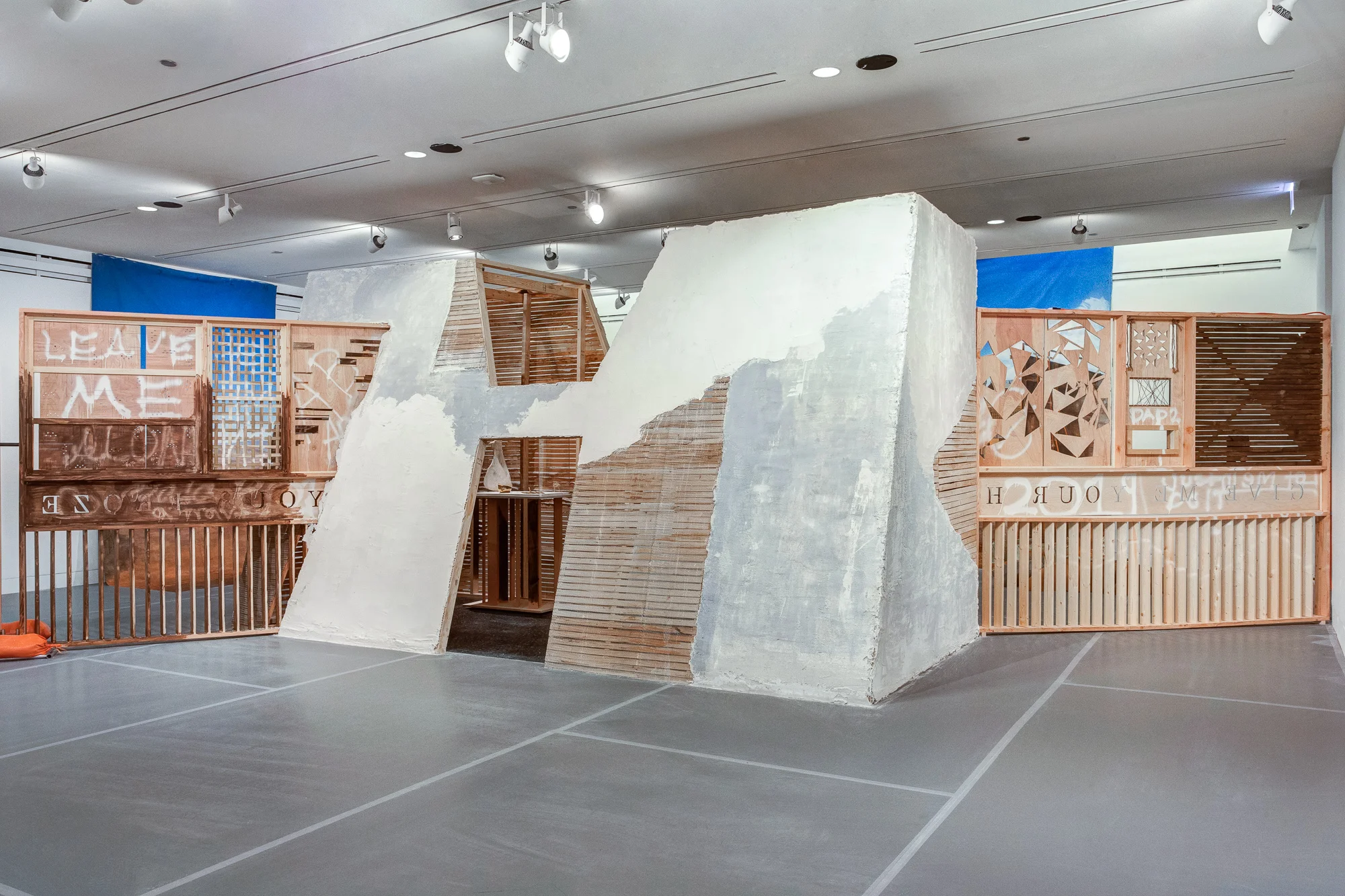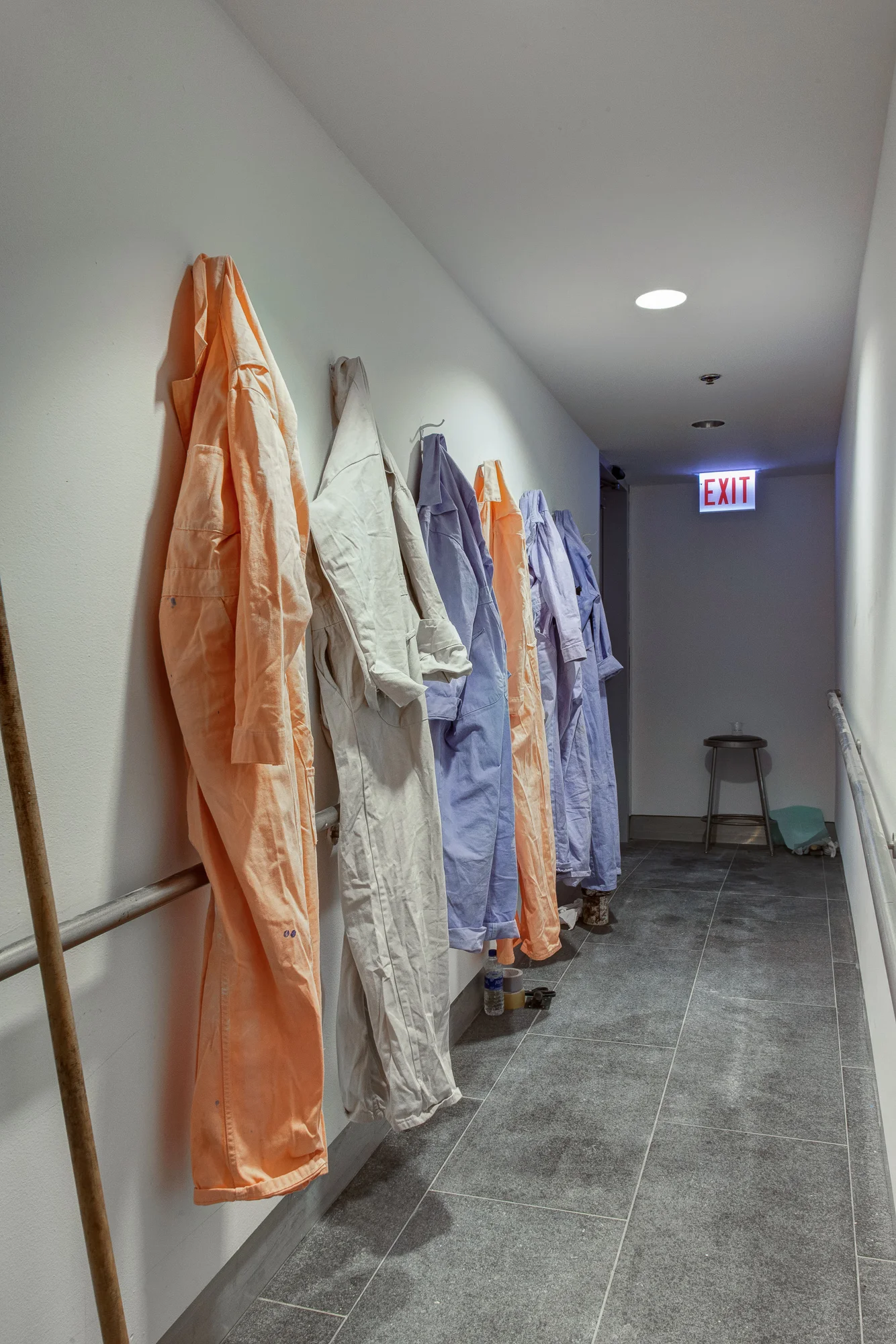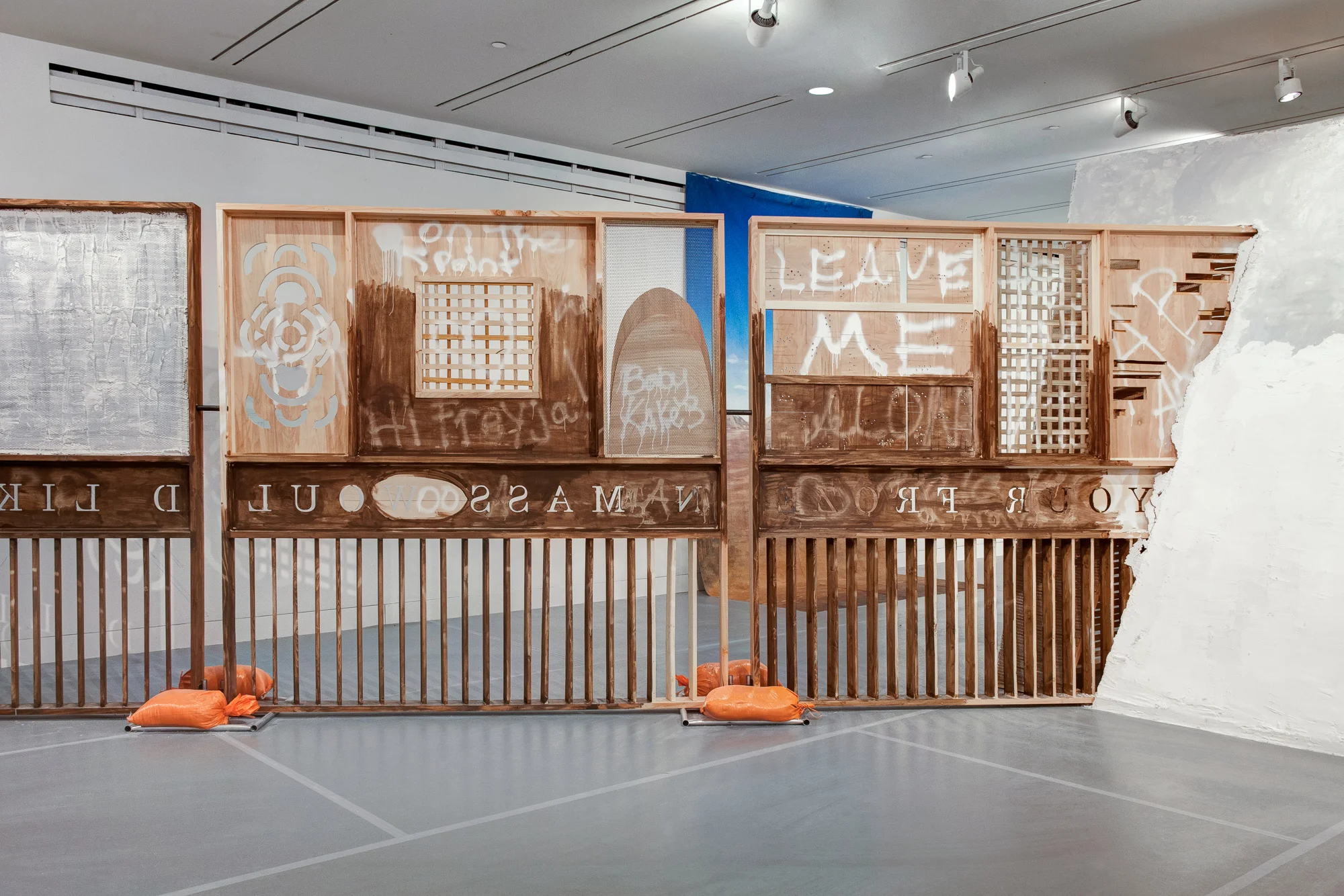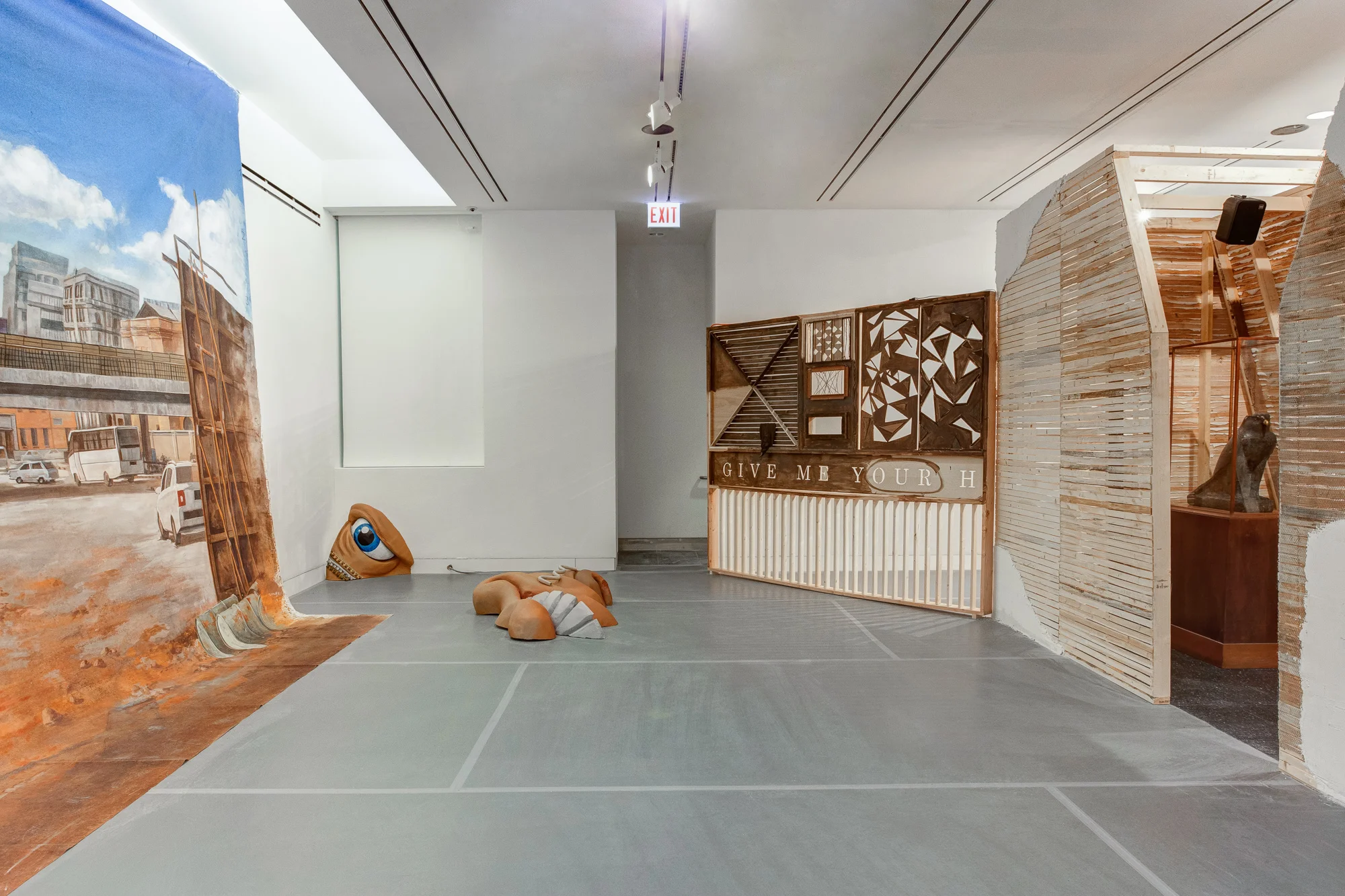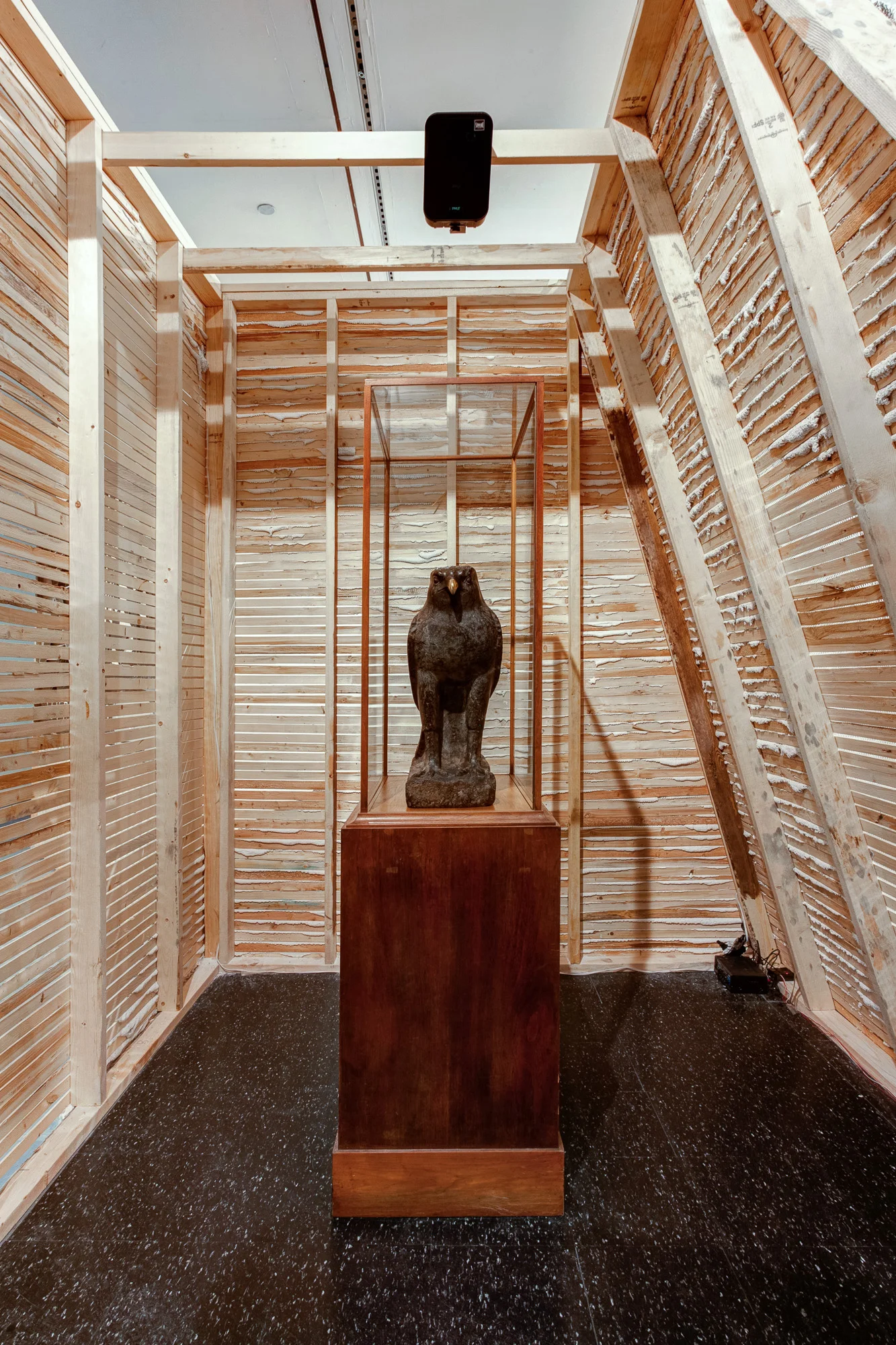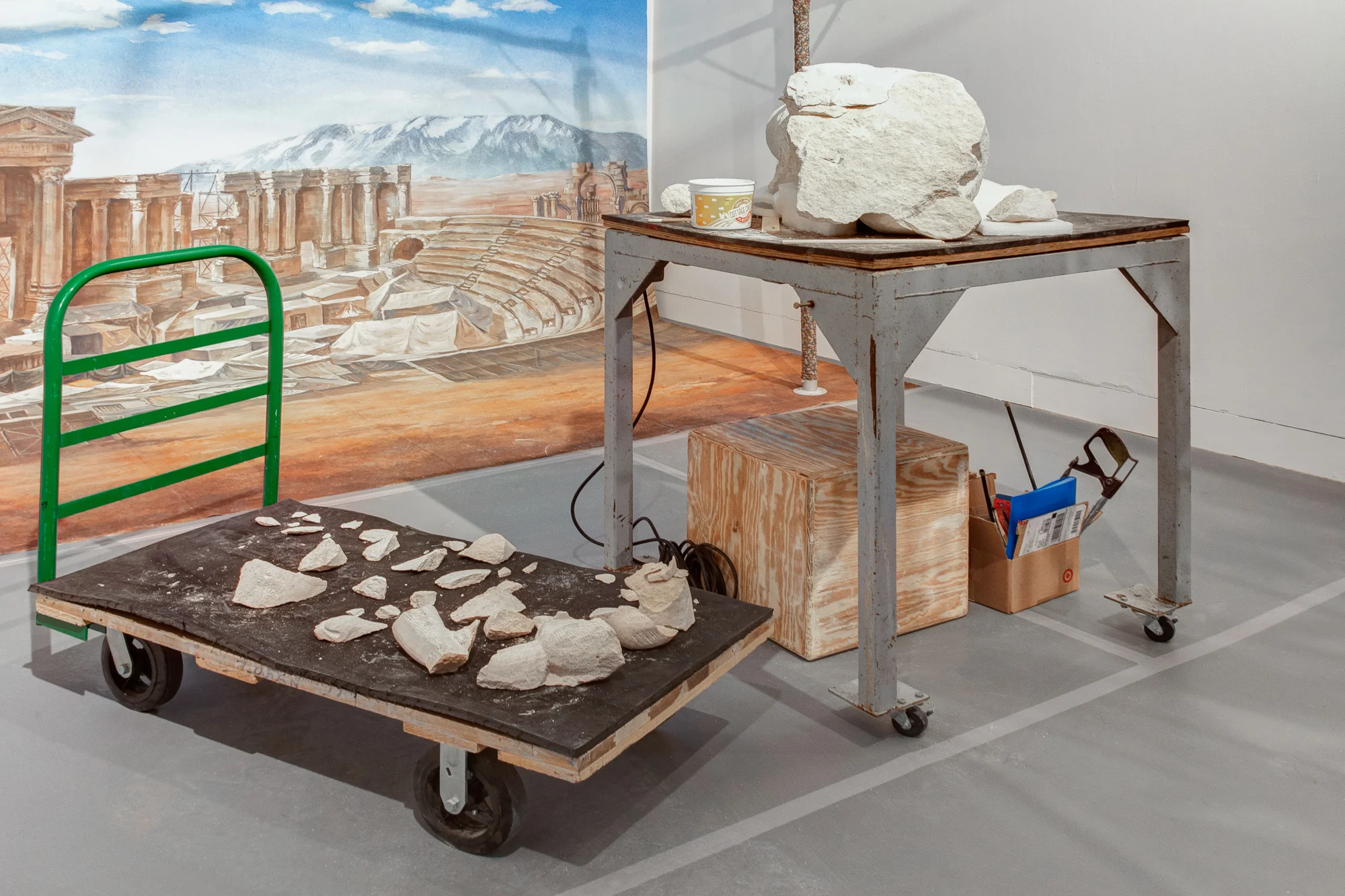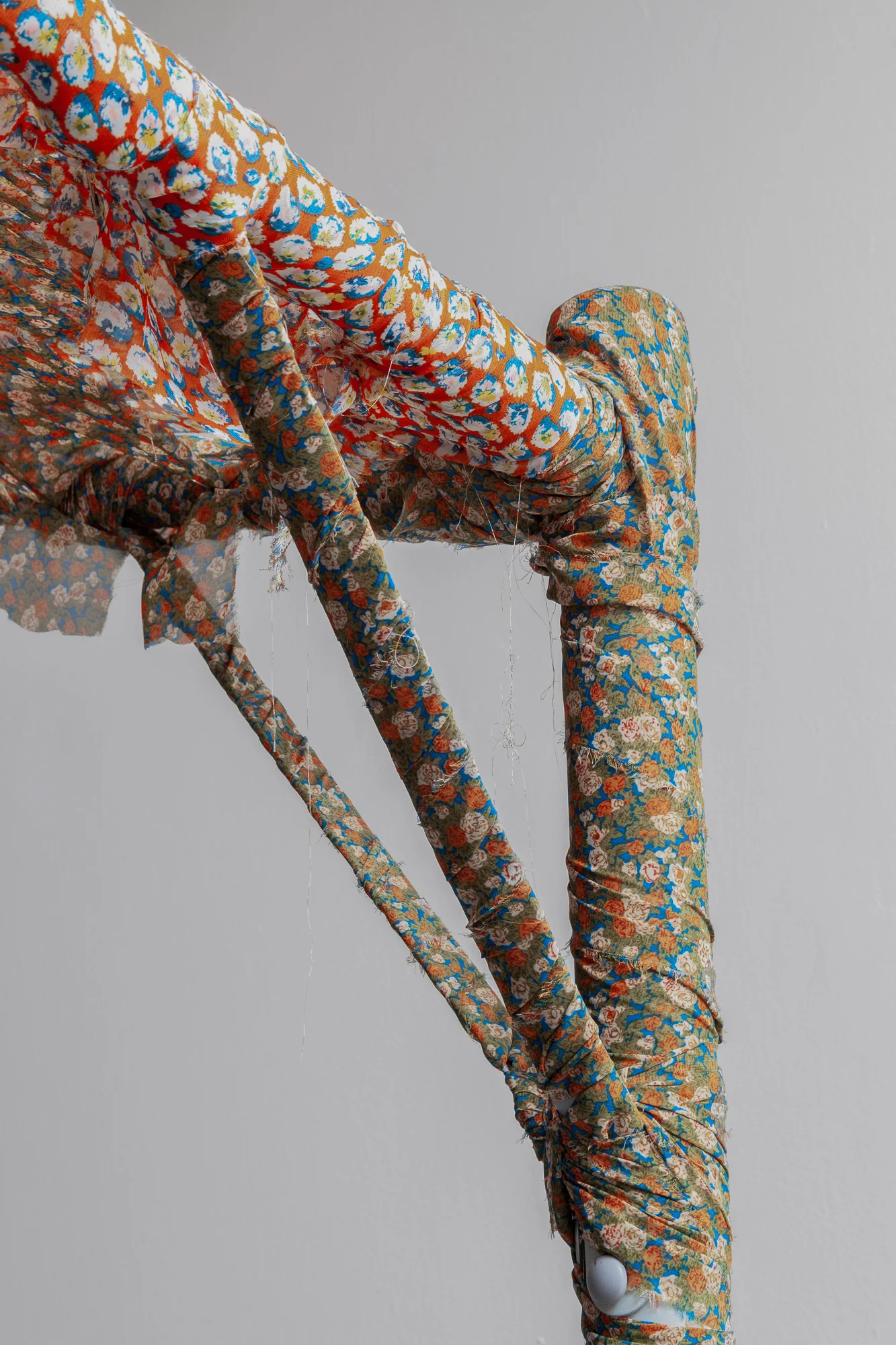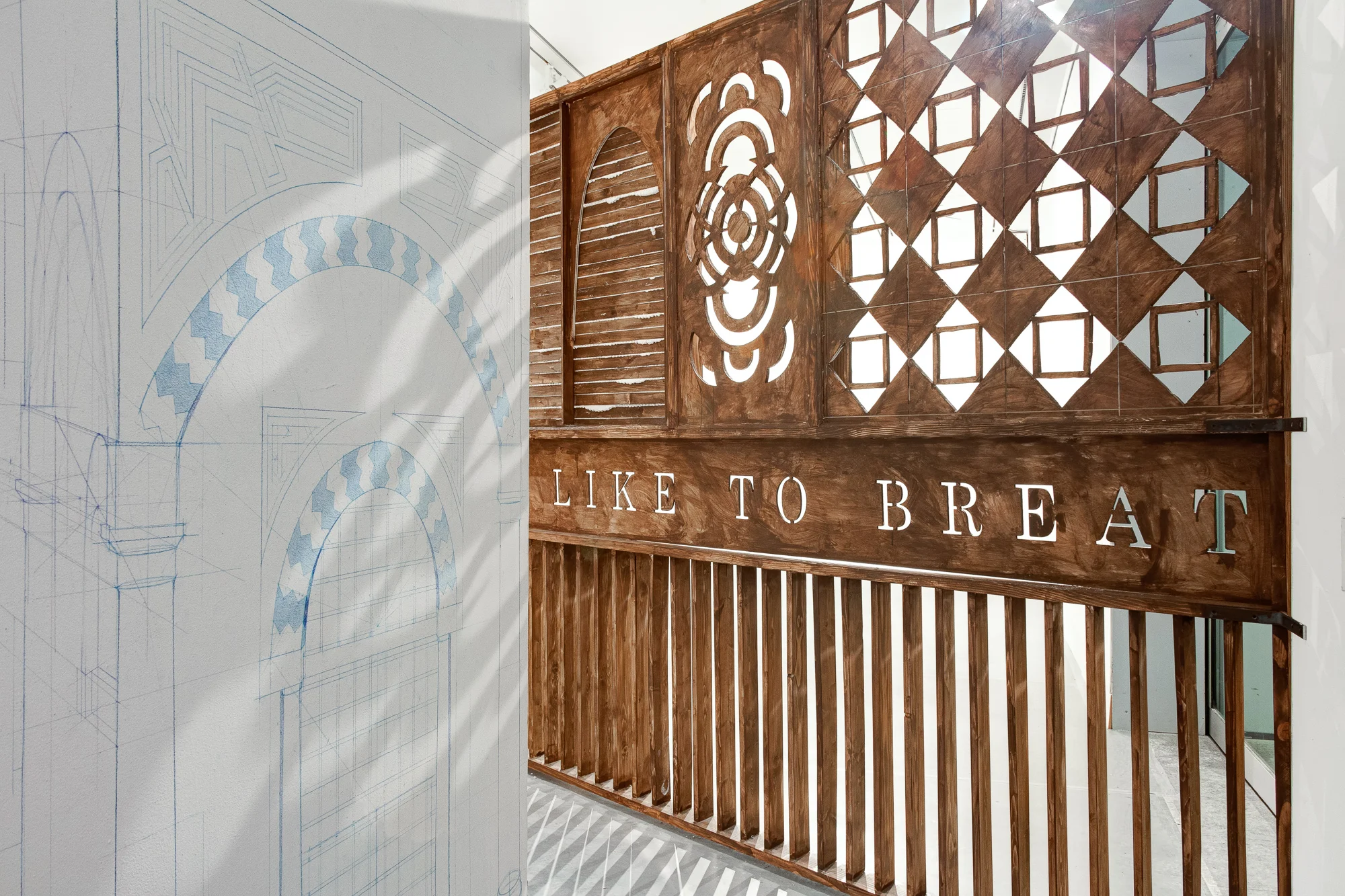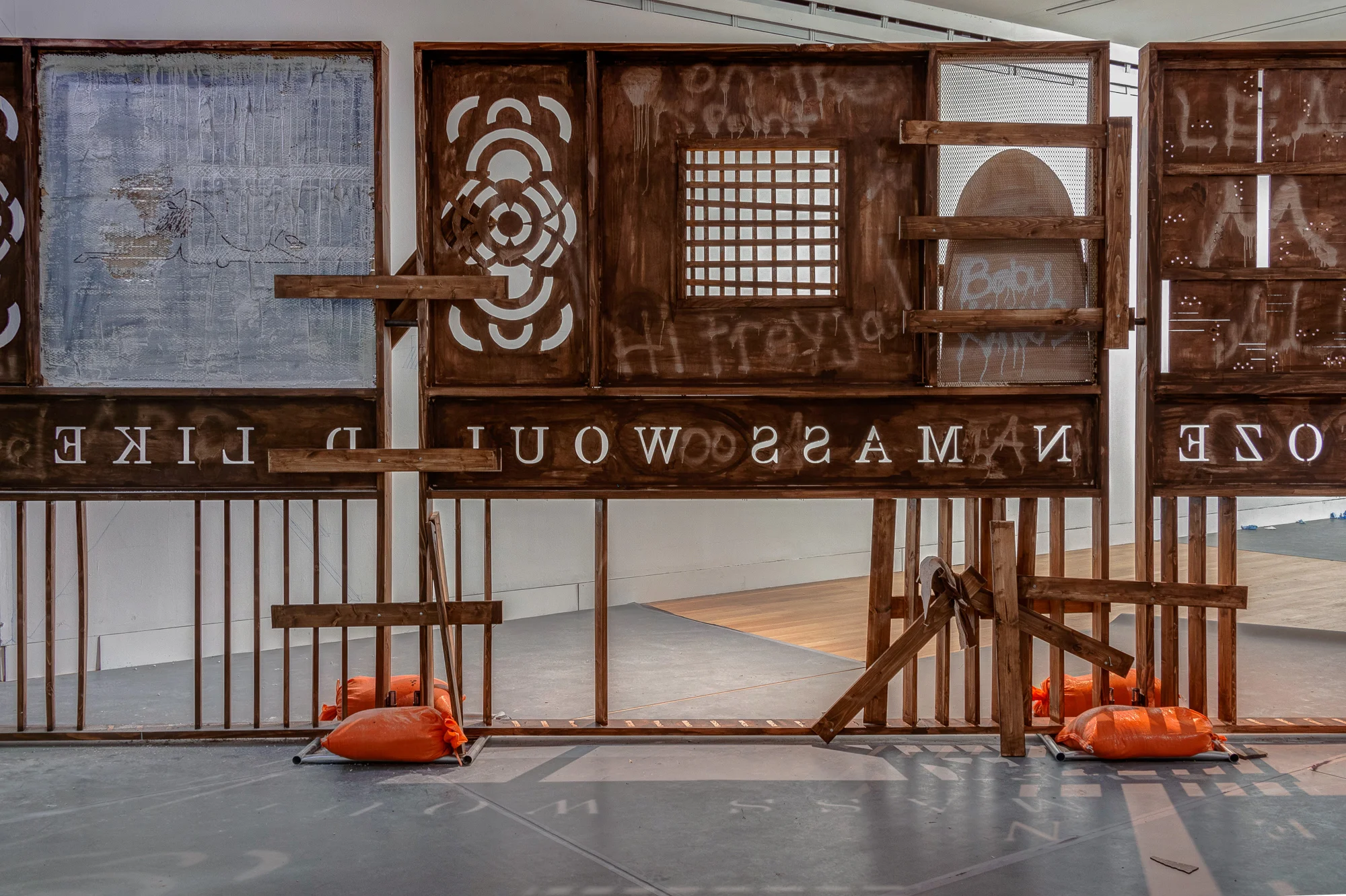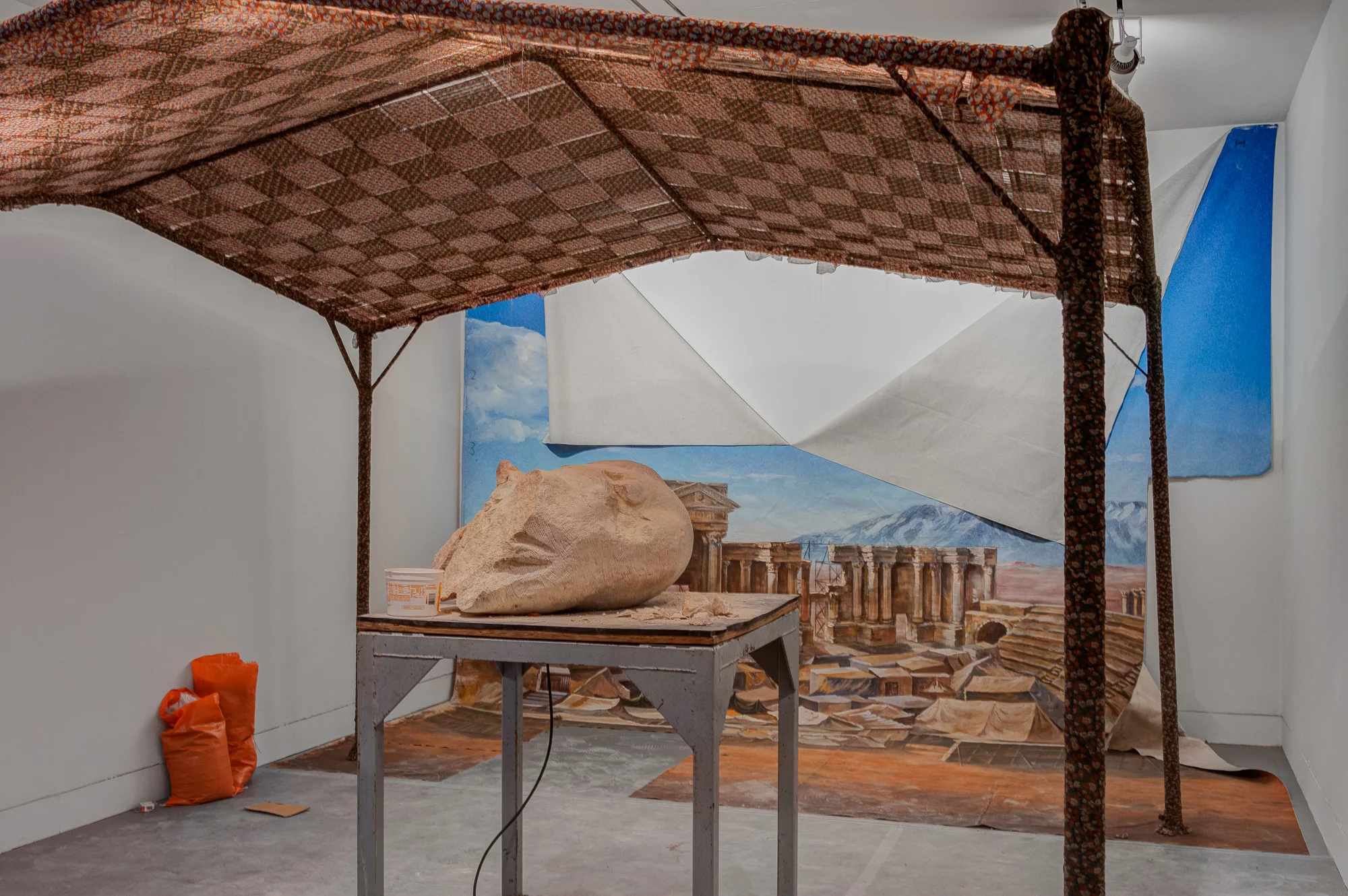Charting Reality with Atlas Unlimited
Installation view of Atlas Unlimited (Acts V-VI). Photo: Robert Chase Heishman
by Jad Dashan, second year student in Art History and Chemistry
Do you know what it feels like to remember something you’ve never experienced, or to fill in the gaps of a disjointed narrative? Has there ever been a moment when you didn’t want to work or move, but were forced to? Have you ever asked a 3000-year-old god for advice?
In the recent Logan Center Exhibitions show, Karthik Pandian & Andros Zins-Browne: Atlas Unlimited (Acts V-VI)—the latest iteration of an ongoing, multinational saga by visual artist Pandian and choreographer Zins-Browne—a combination of sculpture and storytelling explored these questions and others by tracing the flows of people, art, and artifacts across geographies and cultures in the past, present, and future.
Atlas Unlimited charts the story of Zakaria Almoutlak, a Syrian sculptor and refugee collaborating with Pandian and Zins-Browne on the project. Almoutlak's story initially appeared in the project’s first four acts, at Netwerk Aalst and Precarious Pavilions in Belgium, as a hybrid of personal testimony and fiction. In Acts V and VI, on view at the Logan Center in February and March 2019, only artifacts of his story remained. There, a cast of “Builders” parsed his narrative: a mural here evoked his native Palmyra, while a sculptural fragment there alluded to his past occupation. At the Logan Center, Almoutlak’s story flit past the Cairo Street exhibit of the 1893 Columbian Exposition, attended a Rohingya matrimonial ceremony, prayed in Ancient Egypt, and circled back to its native Palmyra.
Builders jumpsuits. Installation view of Atlas Unlimited (Acts V-VI). Photo: Robert Chase Heishman
Throughout the run of Atlas Unlimited, Builders—ranging from an archeologist to a performance maker—activated the gallery every Thursday, invoking stories encoded in the architectural and sculptural fragments constituting its landscape. Plotlines initiated during the opening reception of the show and Act V (Plaisance) were traced and developed during gallery activations, leading up to the closing reception and Act VI (Strike).
On such Thursdays, Builder Sami Ismat, a performance maker from Damascus, would greet gallery visitors in Arabic, letting them know he was “actually playing Zakaria being an actor playing himself as a sculptor.” As part of the exhibition, the actor would transport them through story to various historical and fictional settings, including a 2028 Palmyra—an ancient city reborn as part of the Russo-Syrian state—where hummus is made of Russian chickpeas and there is a bear on the flag, much to Builder Sami’s distaste. His role consisted of inviting visitors to workshop a play with him, set in this political dystopia. With mashrabiya-like screens (an architectural element characteristic of Arabic residences) as a backdrop, Builder Sami’s dramas would only seesaw into reality in moments when he would decide a line was not delivered well enough and rehearse it more. A frequenter to Builder Sami’s theatrics would have noticed him recycling and reforming motifs throughout the run of the show.
Among the settings cooked up was one set in Almoutlak’s family atelier in early-Arab Spring Palmyra. A government official arrives with a commission of grand proportions: the Louvre Abu Dhabi wants Almoutlak to create replicas of its collection of ancient Mesopotamian sculptures to display as public art. Awaiting a response over tea, the actors sense that there’s not much choice for them or Almoutlak.
***
On Thursdays when Builder Sami was not at the gallery, the voice of another Zakaria could be heard in the gallery’s smaller room, the recording of another actor narrating the story. Getting to the voice was tricky, though, with the gallery divided by a long border wall and the only access point to the other side being a small, temple-like structure at its center.
Installation view of Atlas Unlimited (Acts V-VI). Photo: Robert Chase Heishman
One could barely cross its threshold without hearing the voice of a guard, booming throughout with a command to halt. In a glass case sat a large, dark hawk—a sculpture of the ancient Egyptian god Horus—defanged, with a hole in one of his eyes. Just across from him, in another glass case, was his disassembled crown, lying next to a large bone and a small figurine. Builder Tasha Vorderstrasse, a research associate and archeologist at the Oriental Institute, clad in a blue jumpsuit like the other Builders, used her collected composure and calm voice to juxtapose Builder Sami’s more impassioned soliloquies.
Installation view of Atlas Unlimited (Acts V-VI). Photo: Robert Chase Heishman
She offered archeological tours to visitors, detailing the histories of objects like Horus; a large, blue eye melting into the corner of the room; and a curvy flute resting nearby. Her main focus, however, was the Cairo Street of the 1893 Columbian Exposition.
Sculpture of Horus. Installation view of Atlas Unlimited (Acts V-VI). Photo: Robert Chase Heishman
“To describe the curiosities or the quaintness of the Cairo Street would be impossible,” Builder Tasha would often proclaim with her back turned to visitors. “Only a journey there will satisfy curiosity. Visit, in the basking heat of the midday sun, or bathe in the glowing colors of the dying day…in 1893, there was this terrible event which happened in the Cairo Street, and we didn’t really understand what happened because it’s been covered up, but we know something really, really bad-”
“It involved camels, just so you know,” Builder Sami would sometimes interject.
After solemnly agreeing, Builder Tasha would tell the tale of George Pangolo, a Greek man working for the English, who were occupying Egypt at the time, and organizer of the Cairo Street. Builder Tasha’s tale went thus: upon realizing that the exhibit was the most lucrative attraction of the 1893 World’s Fair, Pangolo decided he needed more Egyptian camels to earn more money. She would explain that Pangolo decided to import cheap, two-humped camels from Western China to replace the single-humped Arabian ones that did not fair well in the Chicago winter.
“I know!” she would say, acting as Pangolo. “I’ll get the local immigrants, Polish and Irish workers, to play the Egyptians!”
This angered the actual Egyptians, as well as the Irish and Polish actors, and a strike ensued. Little is known about how the conflict resolved itself, or even what happened to the Egyptians, who seemed to vanish. Pangolo insisted they traveled home, but archived correspondence—at least, according to Builder Tasha—reveals that they never made it back. The storyteller let listeners soak in the mystery for a few moments before carrying on.
“Recent excavations in the Midway, however, have led to the discovery of a sculpture which Builder Jane Foley [a professional and accredited conservator] is conserving right now,” Builder Tasha added. “If you’ll follow me-”
“They broke my sculpture!” Builder Sami—or Almoutlak the actor in 2028, or Almoutlak the sculptor of 2018—would cut in.
***
While Builders Tasha and Sami’s interactions were often more harmonious, giving one another feedback on a performance or adding details to each others’ stories, they were sometimes more incongruent, at which point it wasn’t clear whose sculpture it really was being conserved. The narrative crumbled further once listeners arrived in the gallery’s smaller room, where Builder Tasha would abruptly pause.
“In 2028,...Syrian sculptor Zakaria...Almoutlak was invited back to the...free Russo-Syrian state to create...a monument for his nation’s...independence,” she would say, the words rolling out of her mouth jaggedly, as if she were receiving an alien transmission.
Installation view of Atlas Unlimited (Acts V-VI). Photo: Robert Chase Heishman
Meanwhile, Builder Jane continued to work on restoring what Tasha later described as a large, limestone blob, applying epoxy resin to its rough facets and drilling holes in some smaller pieces. On one particular evening, Builder Jane wondered aloud why no one had asked her why the sculpture had been destroyed in the first place, despite the fact that someone had clearly shattered it. “I think everyone wants to destroy things,” she concluded gravely, calling into question what is retrieved, lost, and added in the process of archeological restoration.
Builder Mohammad Miah’s traditional Rohingya textiles covering the Builder Jane’s sculpture. Installation view of Atlas Unlimited (Acts V-VI). Photo: Robert Chase Heishman
The ceremonial wedding tent under which Builder Jane’s work was done was meticulously put together by Builder Mohammad Miah, a professional Burmese tailor who is on the board of the Rohingya Cultural Center in Chicago. Every Thursday, he incorporated more traditional Rohingya textiles into the tent, their rich patterns beautifully fracturing the light.
Concurrently, Builder Sami’s voice could be heard in the gallery’s main room, greeting newcomers with السَّلَامُ عَلَيْكُمْ (As-Salaam-Alaikum) and talking about his—Almoutlak’s—prison experience, or lambasting Gian Lorenzo Bernini, a 17th Century Italian sculptor. He was in a constant state of conflict, which he rehearsed with unsuspecting visitors who either tried to mollify his anger or amplify it.
***
Builder Sami’s antics stood in stark contrast to Builder Tasha’s tour, who employed a more chronological form of storytelling. Returning to the main gallery’s border wall, with its graffitied wooden panels and numerous peep-holes to the other side, Builder Tasha resumed Pangolo’s story, explaining that the wall panels were the same mashrabiya screens that were exhibited in the World’s Columbian Exposition in 1893, lent by the Field Museum.
“So, George Pangolo, in addition to his striker-beating, camel-lying ways, was also involved in destroying buildings in Cairo,” she would say, describing the way Pangolo and his team demolished homes in the city. However, the wood in the gallery lacked the trauma her stories implicated, and British imperialism wasn’t enough of an explanation for the English lettering on the panels. But Builder Tasha never failed to cite an obscure historical fact to refute rebuttals, even as Builder Gabe Moreno applied wood stain to the supposed artifact. While some listeners were fascinated by the “behind-the-scenes” scoop Builder Tasha provided, others explicitly questioned the validity of her story. In either case, the doubt often stayed with visitors as they left the gallery.
Installation view of Atlas Unlimited (Acts V-VI). Photo: Robert Chase Heishman
One particularly striking inconsistency was between the mashrabiya screens and Builder Anthony Adcock’s wall-drawing of the Cairo Street exhibit positioned near them. The sharp, architectural sketches, rendered in blue, seem like more faithful depictions of medieval Egyptian architecture. Other parts of Builder Anthony’s drawings melded into murals hung on the gallery walls, imported from a previous iteration of Atlas Unlimited. A fine artist and iron worker, Builder Anthony’s drawings of artificial walls used in film sets successively transform into rectangular segments reminiscent of a border wall, particularly relevant to current American political discussions.
***
At the exhibition’s end, Builder Anthony’s drawings were erased in Act VI (Strike), which was something between a street parade and a chaotic rift in spacetime. Floor tiles were hurled into the air and smashed with hammers; wooden panels were knocked out from the wall, now no longer a boundary in the gallery; and towering canvases on the walls were torn down, with the evening concluding in song. Recovered from his half-destroyed temple, Horus—now played by an actor—was lifted from the ruins and wheeled off into the distance by a troop of Builders carrying other detritus.
Installation view of Atlas Unlimited (Acts V-VI). Photo: Robert Chase Heishman
Atlas Unlimited vigorously shakes the fluid interface of the narratives we tell about migration, disturbing the surface and dissolving truths while disinterring others. The project underscores how stories change as they are constructed, reconstructed, stolen, forgotten, and erased. Its brief sojourn at the Logan Center Gallery began with promises of construction and retrieval—of images, objects, characters, and meaning. By the end, those promises were dashed by acts of destruction and defiance, which proved to be just as meaningful.
Karthik Pandian & Andros Zins-Browne: Atlas Unlimited (Acts V—VI) was on view at the Logan Center Gallery February 1—March 17, 2019.

